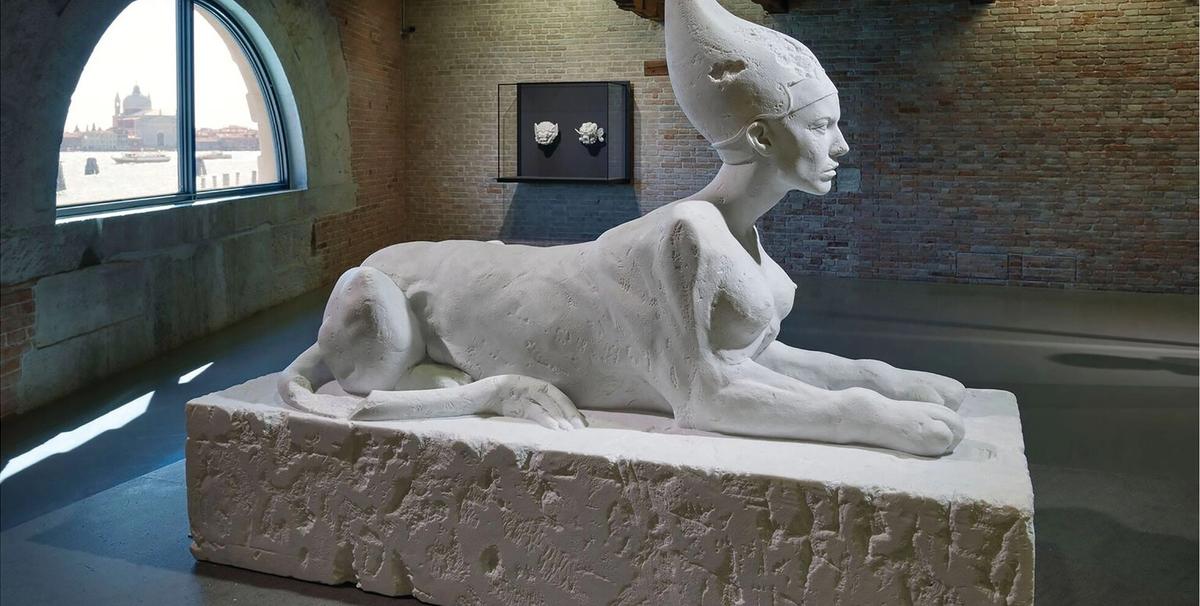Damien Hirst’s monumental show, Treasures from the Wreck of the Unbelievable, looks and feels utterly gorgeous. It is an extraordinary assemblage of more than 2,000 objects, carefully raised from the seabed from the wreck of the Apistos and convincingly displayed in the Punta della Dogana and Palazzo Grassi, two of Venice’s heavyweight museums.
Here is a statue of Laocoön writhing in agony, there a coral-encrusted sphinx. There are shields from ancient Greece, swords and scabbards, a cabinet filled with ancient artefacts that would not be out of place in the Pitt Rivers Museum in Oxford. But none of it is real. It is all an illusion. In a world growing used to fake news, we now have fake heritage.
This is nothing new. History is littered with examples of counterfeit history. I visited the Horniman Museum in south London recently. It opened its doors in 1890 to “bring the world to Forest Hill”, and is a treasure trove of fossils, musical instruments and stuffed animals. In a case of its own is a “merman”. Blackened, twisted and grotesque, it glares out with unmistakable fish tail and grotesque human[ish] head. It isn’t alone. Numerous other museums across the world proudly display their own mermen. All made by Frankensteinian hands combining everything from monkey heads and fish bodies to chicken claws, papier-mâché and wire.
The circus showman P.T. Barnum famously exhibited one in 1842 named the FeeJee Merman, which sparked yet more “discoveries”. All fake, and part of a long trend that can be traced back to a centuries-old Shinto tradition in Japan.
In 1912, the amateur archaeologist Charles Dawson and British Museum geologist Arthur Woodward announced the discovery of Piltdown Man—the missing evolutionary connection between humans and apes. It was not until 40 years later that the hoax was revealed—the jawbone came from an orangutan and the skull from a human.
The list goes on: the Calaveras Skull from California found in 1866, the Tiara of Saitaferne (acquired by the Louvre in 1896), the Shapira Strips (presented as an ancient scroll in 1883) and, my favourite, the Cardiff Giant.
This three-metre-tall “petrified” man, allegedly found in 1869 in Cardiff, New York, was actually carved from a single block of gypsum, given “pores” and aged using acid. A giant fake giant, it prompted Barnum to create a replica when his offer to purchase the original from its owner, David Hannum, was rejected—a fake, fake giant. Inevitably, the two were soon at loggerheads over authenticity and took their dispute to court. The judge promised a favourable outcome for Hannum, but only if his giant attended the injunction personally and swore to its “own genuineness”. It failed to turn up. You couldn’t make it up—but then again, perhaps you could. After all, they did.
Or what of the countless sham ruins that adorn the landscapes of Europe’s stately homes? Want a distressed Gothic castle to complement your mansion? In the 18th century the go-to architect was Sanderson Miller, a man famous for his ready-distressed designs for places such as Wimpole in Norfolk and Hagley in Worcestershire. Deliberately ruined walls, incomplete towers, elaborate traceried windows opening on to nothing but fresh air, all designed to catch the eye and celebrate links to a distant and noble past, real and unreal.
And it is not all about Georgian or Victorian deceit. The London Blue Plaque scheme, run by English Heritage and the oldest in the world, has spawned many similar projects across the UK. Its more than 900 circular blue medallions adorn buildings around the city, tagging them with an authentic stamp declaring that Charles Dickens, Horace Walpole or Freddie Mercury “lived here”.
More recently there has been a spate of bogus plaques. Fans of the late Graham Chapman, disgruntled that the Monty Python actor was dropped from the official scheme, decided to erect one in his memory in central London. It reads: “Jacob Von Hogflume 1864-1909, inventor of time travel, lived here… in 2189”. Providing it does not fall foul of local planning legislation and has the appropriate permission of the owner, there is nothing to stop anyone erecting such a sign and creating their own piece of “history”. So, what’s new? Is there a difference between Hirst’s treasures and the missing links of the antiquarians? Many from the past set out to deceive, to hoodwink, each desperate to prove an academic first or generate a profitable sale. Contrarily, Hirst doesn’t really want to fool us: part of the point of the show is our realising its untruth. He is playing a game.
The clue is in the title, both of the exhibition and of the ship, Apistos being Ancient Greek for incredible or incredulous, unbelievable. The sunken treasure supposedly belonged to Cif Amotan II, an anagram of “I am a fiction”.Look closer at the Venice exhibition. Isn’t that Hirst’s own head, and Kate Moss as a winged Egyptian goddess, and a barnacle encrusted Goofy? Knowing nods and clues litter the galleries. But, like Barnum, no one could excuse Hirst of being commercially naïve. Money does come into it.
There are almost 200 separate works of art for sale, each in an edition of five. The highest is reportedly priced at $14m, but you may purchase a signed book documenting the recovery of the treasure, part of a limited edition of 1,000, for $320.
There’s been a lot invested across the two galleries. The alchemy of the commercial art world aside, ultimately this is heritage that reflects the 21st century rather than the distant past. It speaks of fake news, bling and reality TV, of the over-saturated colours of Instagram or the exaggerated fantasy world of CGI and video-gaming. It is heritage extreme.
Welcome to the Palaeo-ironic Era.


